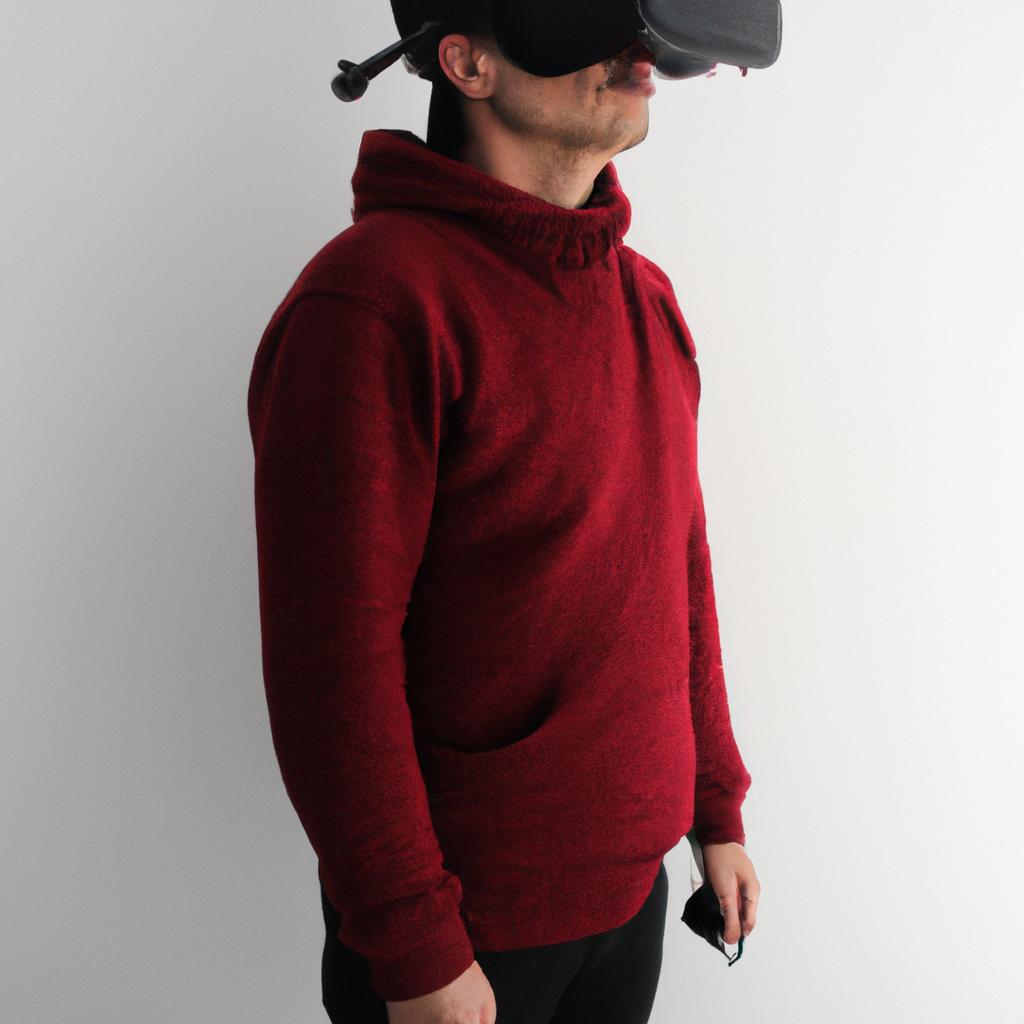Virtual Reality Experiences: Unleashing the Potential in Games and Video Games

Virtual reality (VR) technology has revolutionized the way we experience games and video games, offering users an immersive and interactive environment that transcends traditional forms of entertainment. This article explores the potential of virtual reality experiences in gaming, delving into the captivating possibilities it presents for both gamers and developers alike. By examining a hypothetical case study involving a popular VR game, this article aims to shed light on the transformative power of virtual reality in enhancing gameplay and creating unique user experiences.
In recent years, virtual reality has gained significant traction within the gaming industry due to its ability to transport players into fictional worlds with unprecedented realism. One notable example is the renowned VR game “The Elder Scrolls V: Skyrim VR.” In this game, players can assume the role of a character navigating through a vast medieval world, complete with breathtaking landscapes and detailed characters. The integration of virtual reality technology elevates the gaming experience by allowing players to physically interact with objects within the game world using motion controllers. Such immersion creates a heightened sense of presence and engagement, enabling gamers to truly feel like they are part of this fantastical universe.
By harnessing the potential offered by virtual reality in gaming, developers have recognized new avenues for innovation and creativity. Beyond replicating real-world scenarios or fantasy environments , virtual reality allows developers to explore entirely new realms of possibility. They can create unique and imaginative worlds that defy the laws of physics and challenge traditional gameplay mechanics. For example, in the VR game “Superhot VR,” time only moves when players do, creating a thrilling and strategic experience where they must carefully plan their movements to overcome enemies.
Moreover, virtual reality enables developers to design games that cater to different play styles and preferences. With the ability to customize controls and settings, players can tailor their virtual reality experience to suit their comfort level or desired level of challenge. This flexibility enhances accessibility and inclusivity within the gaming community, ensuring that individuals with various abilities can enjoy immersive gameplay.
Virtual reality also opens up opportunities for social interaction within gaming. Multiplayer VR experiences allow players from around the world to connect and collaborate in shared virtual spaces. Whether it’s teaming up in cooperative missions or competing against each other in intense battles, virtual reality fosters a sense of camaraderie and community amongst gamers.
In addition to its impact on gameplay, virtual reality technology has implications for storytelling within gaming. By immersing players in rich narrative environments, developers can create emotionally compelling experiences that resonate deeply with players. Through realistic graphics, lifelike character interactions, and dynamic audio design, virtual reality amplifies the emotional connection between players and the game world.
The potential of virtual reality in gaming is still being explored and expanded upon by developers worldwide. As technology continues to advance, we can expect even more innovative uses of virtual reality that push the boundaries of what is possible in gaming. From fully simulated worlds to interactive narratives that blur the line between fiction and reality, virtual reality holds immense promise for transforming how we play games and experience entertainment as a whole.
The Evolution of Gaming Technology
Virtual reality (VR) has revolutionized the gaming industry, offering players an immersive and realistic experience like never before. One notable example is the game “Beat Saber,” where players use VR headsets and motion controllers to slash through beats in a musical landscape. This case study highlights how VR technology has evolved over time, allowing for more engaging gameplay.
Advancements in Hardware
The development of VR technology can be traced back to the 1960s when Ivan Sutherland created the first head-mounted display system called the “Sword of Damocles.” Since then, there have been significant advancements in hardware that have made virtual reality accessible to a wider audience. Today, high-resolution displays with low latency provide users with crystal-clear visuals and reduce motion sickness often associated with earlier iterations of VR devices.
Seamless Integration
Another crucial aspect of VR’s evolution is seamless integration across different platforms. Whether it is PC-based systems or mobile devices, developers have ensured compatibility so that gamers can enjoy their favorite titles regardless of their preferred platform. This versatility allows for easy accessibility and expands the user base for VR experiences.
Enhanced Interactivity
One key feature that sets virtual reality apart from traditional gaming is its enhanced interactivity. In addition to using hand-held controllers, new technologies such as haptic feedback suits enable players to feel physical sensations within the virtual world. This heightened level of interaction adds depth to gameplay and creates a truly immersive experience.
To evoke an emotional response from audiences regarding the impact of VR on gaming, consider the following bullet points:
- Increased realism: Lifelike graphics and responsive controls transport players into stunningly detailed worlds.
- Heightened excitement: Immersive audio design amplifies emotions by creating a sense of presence within the game environment.
- Unforgettable memories: Virtual reality provides unique experiences that leave lasting impressions on players’ minds.
- Expanded possibilities: VR allows for innovative gameplay mechanics and narrative structures that were previously unattainable.
To further engage readers, a table can be included to showcase the evolution of key features in gaming technology:
| Hardware Advancements | Seamless Integration | Enhanced Interactivity | |
|---|---|---|---|
| 1. | High-resolution displays with low latency give clear visuals. | Compatibility across multiple platforms ensures accessibility. | Haptic feedback suits enable physical sensations within virtual worlds. |
| 2. | Improved motion tracking enhances player immersion. | Cross-platform compatibility expands user base. | Interactive hand-held controllers heighten interactivity. |
| 3. | Wireless connectivity eliminates cable limitations. | Cloud-based storage enables seamless game progress synchronization. | Voice recognition enhances communication within immersive environments. |
| 4. | Real-time multiplayer capabilities provide shared experiences. | Social media integration facilitates community engagement. | Artificial intelligence advancements create lifelike NPCs. |
In summary, the evolution of VR gaming technology has brought about significant changes in hardware, integration, and interactivity, resulting in more engaging gameplay experiences for players worldwide.
Transitioning into the subsequent section on “Immersive Gameplay: A New Level of Engagement,” it is evident that these advancements have paved the way for an exciting era of gaming where players can fully immerse themselves in captivating virtual worlds without any hindrances or limitations imposed by traditional gaming systems.
Immersive Gameplay: A New Level of Engagement
Virtual reality (VR) technology has revolutionized the gaming industry, offering immersive experiences that transport players into virtual worlds. This section will explore how VR has unleashed the potential in games and video games, taking gameplay to new heights of engagement and interactivity.
One compelling example of this is the game “Beat Saber,” a rhythm-based VR experience where players use motion controllers to slash beats represented by colored blocks with corresponding sabers. By combining music, visuals, and physical movement, “Beat Saber” creates an exhilarating experience that challenges players’ reflexes and coordination. This case study highlights the transformative power of VR in delivering unique and captivating gameplay.
The impact of VR on gaming can be attributed to several key factors:
-
Immersion: VR allows players to step inside the virtual world, providing a sense of presence and immersion like never before. The combination of stereoscopic visuals, spatial audio, and responsive haptic feedback enhances the player’s perception of being physically present in the game environment.
-
Interactivity: Traditional gaming often involves pressing buttons or manipulating joysticks, but VR introduces intuitive interactions through hand tracking or motion controllers. Players can physically reach out, grab objects, and manipulate their surroundings within the virtual space, creating a more tactile and interactive gameplay experience.
-
Emotional Engagement: With its ability to create realistic environments and evoke emotional responses from players, VR opens up opportunities for storytelling on a whole new level. Whether it’s fear in a horror game or awe-inspiring moments in an adventure title, VR amplifies emotions by immersing players directly into these virtual scenarios.
-
Social Interaction: While gaming was traditionally considered a solitary activity, VR brings multiplayer experiences to life like never before. Friends can join each other virtually from different locations around the world, collaborating or competing together in shared virtual spaces.
| Benefits of Virtual Reality Gaming |
|---|
| Enhanced immersion |
| Intuitive interactivity |
| Amplified emotional engagement |
| Social interaction |
In conclusion, virtual reality technology has unlocked new possibilities for games and video games. Through its immersive nature, intuitive interactions, emotional engagement, and social capabilities, VR takes gameplay to unprecedented levels of excitement and involvement.
Building upon the transformative power of VR in gameplay, let’s now delve into how this technology can enhance storytelling within virtual worlds.
Enhancing Storytelling through Virtual Reality
Transitioning from the previous section, where we explored the concept of immersive gameplay in virtual reality experiences, let us now delve into how virtual reality enhances storytelling. To illustrate this point, consider a hypothetical scenario where players are transported to a post-apocalyptic world through their VR headsets. As they navigate through desolate landscapes and encounter various challenges, the emotional intensity is heightened by their ability to physically interact with the environment and characters.
One compelling aspect of virtual reality’s impact on storytelling lies in its ability to evoke strong emotions within players. By immersing individuals in vividly constructed digital worlds, developers can harness the power of empathy and create memorable narrative experiences. This heightened emotional engagement results from several key factors:
- Sensory stimulation: Virtual reality allows for a multi-sensory experience, incorporating sight, sound, and even touch to provide a more realistic and engaging environment.
- Agency and interactivity: Players have agency over their actions within the story, making choices that influence the outcome or shape character relationships.
- Presence and embodiment: Through VR technology, users feel a sense of presence within the game world as they embody avatars or interact directly with objects and characters.
- Spatial storytelling: Virtual reality enables innovative spatial storytelling techniques such as 360-degree environments, which immerse players fully in the narrative setting.
To highlight these aspects further, let us examine a comparison between traditional video games and virtual reality experiences using a table format:
| Traditional Video Games | Virtual Reality Experiences |
|---|---|
| Limited immersion due to screen-based interaction | Full immersion through sensory input |
| Passive observation of events unfolding on-screen | Active participation in events as an embodied player |
| Emotional connection primarily through visual cues | Enhanced emotional connection through physicality and spatial presence |
| Disconnected experience from real-world surroundings | Engaged experience blurring boundaries between real and virtual |
In summary, virtual reality’s ability to enhance storytelling lies in its capacity to evoke emotions through sensory stimulation, agency and interactivity, presence and embodiment, as well as spatial storytelling techniques. By immersing players fully into the narrative world, developers can craft experiences that leave a lasting impact on their audience.
As we have explored how virtual reality enhances engagement and storytelling within gaming experiences, let us now shift our focus to the broader implications of this technology for revolutionizing the gaming industry.
Revolutionizing the Gaming Industry
Virtual reality (VR) has not only enhanced storytelling but also revolutionized the gaming industry. By immersing players in a virtual world, VR technology provides an unprecedented level of engagement and interactivity. This section explores how VR has transformed the gaming experience, enabling new possibilities for game design and player interaction.
One example that showcases the potential of VR in gaming is “Half-Life: Alyx.” Released in 2020, this VR-exclusive game takes players on an immersive adventure set in the iconic Half-Life universe. The game’s use of VR mechanics allows players to physically interact with objects, solve puzzles, and engage in intense combat scenarios. By harnessing the power of VR, “Half-Life: Alyx” creates a sense of presence and agency like never before, drawing players deeper into its narrative.
The impact of VR on the gaming industry can be further understood through the following points:
- Enhanced Immersion: With VR headsets providing a 360-degree field of view and spatial audio technologies creating realistic soundscapes, games have become more immersive than ever before.
- Increased Interactivity: Through motion controllers or haptic feedback devices, players can now physically interact with their virtual surroundings, adding a new layer of realism and tactile engagement.
- Novel Gameplay Mechanics: VR opens up opportunities for innovative gameplay mechanics such as climbing walls using hand gestures or crafting items by manipulating virtual materials.
- Expanded Genre Possibilities: From first-person shooters to puzzle-solving adventures and even simulations like flight or racing experiences, VR enables diverse genres to thrive by offering unique perspectives and interactions.
To better visualize these advancements enabled by VR technology, consider the following table showcasing examples of popular games across different genres and their corresponding improvements when played in virtual reality:
| Genre | Traditional Game Features | Virtual Reality Enhancements |
|---|---|---|
| First-Person | Limited perspective | Full immersion and realistic movement |
| Puzzle | Static puzzles | Interactive object manipulation and spatial challenges |
| Simulation | Limited control options | Realistic hands-on experiences and physical interactions |
| Adventure | Passive exploration | Active participation in the virtual world |
By embracing VR, the gaming industry has witnessed a paradigm shift. Players are no longer constrained by traditional gameplay mechanics but can instead immerse themselves fully in interactive worlds that respond to their actions. This revolutionization of the gaming experience sets the stage for further innovations in game design and player engagement.
Transitioning into the subsequent section about “Unleashing Creativity in Game Design,” we explore how VR’s impact extends beyond enhancing existing games to empowering developers with new tools and possibilities for creating immersive experiences.
Unleashing Creativity in Game Design
Transitioning from the revolutionary impact of virtual reality (VR) on the gaming industry, we now turn our attention to its ability to unleash creativity in game design. VR technology has opened up new possibilities for developers and designers, allowing them to create immersive and interactive experiences that were previously unimaginable. To illustrate this point, let us consider a hypothetical example.
Imagine a futuristic, science fiction-themed video game where players are transported into an alien world through their VR headsets. As they explore this foreign environment, they encounter unique creatures and landscapes that come to life in breathtaking detail. The level of immersion provided by VR allows players to experience the sights and sounds of this fictional universe as if they were truly there. This enhanced realism creates a sense of wonder and excitement that traditional gaming platforms cannot replicate.
The potential of VR technology goes beyond just enhancing visual and auditory elements; it also opens up avenues for innovative gameplay mechanics. With motion tracking sensors and hand controllers, users can physically interact with objects within the virtual world. For instance, players could solve puzzles by picking up and manipulating objects or engage in intense sword fights using realistic gestures. These tactile interactions add depth to gameplay experiences, making them more engaging and memorable.
To further emphasize the creative possibilities afforded by VR in game design, consider the following benefits:
- Enhanced storytelling capabilities: By immersing players in richly detailed environments, VR enables developers to craft compelling narratives that unfold around them.
- Increased player agency: Through interactivity and decision-making opportunities, games designed for VR empower players by giving them greater control over their experiences.
- Emotional resonance: The heightened sensory immersion provided by VR intensifies emotional responses such as fear, excitement, or joy.
- Novel perspectives: Virtual reality allows for unique camera angles or viewpoints not possible in traditional gaming setups, offering fresh ways of experiencing game worlds.
Moreover, these advantages are best appreciated when viewed in the context of a comparison between traditional gaming and VR experiences. The table below illustrates some key distinctions:
| Aspect | Traditional Gaming | Virtual Reality Experiences |
|---|---|---|
| Interaction | Button presses, joystick movements | Gestures, physical movement |
| Immersion | Limited immersion due to screen-based visuals | Deep sense of presence through immersive environments |
| Socialization | Primarily solo or online multiplayer interactions | Enhanced social experiences with shared virtual spaces |
| Realism | Visuals and sounds on a flat screen | Lifelike environments and audio that mimic real-world sensations |
As we can see, VR offers game designers an unprecedented canvas for creativity. By harnessing its capabilities, developers can craft truly unique and memorable gaming experiences that captivate players like never before.
Having explored the creative potential unleashed by VR in game design, let us now delve into the numerous benefits offered by virtual reality experiences in gaming.
Benefits of Virtual Reality Experiences in Gaming
Unleashing Creativity in Game Design has long been a fundamental goal for game developers. However, the advent of virtual reality (VR) experiences has revolutionized this aspect of gaming by offering unprecedented opportunities to immerse players in new worlds and harness their creativity. By blurring the lines between reality and fiction, VR enables game designers to craft unique and captivating experiences that push the boundaries of imagination.
One intriguing example of how virtual reality can unleash creativity is demonstrated through the case study of “Ethereal Odyssey.” This immersive VR game transports players into a mystical realm where they embark on an epic journey as they encounter mythical creatures, solve puzzles, and overcome challenges. The incorporation of interactive elements within Ethereal Odyssey allows players to actively participate in shaping the outcome of the story, fostering a sense of agency and personal investment. This level of immersion empowers players to express their creative ideas within the confines of the game’s universe.
The benefits provided by virtual reality experiences in gaming extend beyond mere entertainment value. They have profound implications for enhancing cognitive abilities, emotional engagement, and social interaction among players. Consider these key advantages:
- Enhanced Cognitive Abilities: Virtual reality games often require users to think critically, solve complex problems, and make quick decisions in dynamic environments. These mental exercises stimulate cognitive functions such as memory retention, attention span improvement, and spatial reasoning skills.
- Emotional Engagement: Immersive storytelling techniques combined with realistic graphics and audio design enable gamers to emotionally connect with characters and narratives on a deeper level than traditional mediums allow. This heightened emotional engagement intensifies player involvement and enriches overall gameplay experiences.
- Social Interaction: Multiplayer functionalities integrated into virtual reality games promote collaboration, communication, and teamwork among players from different locations worldwide. Through shared immersive experiences, individuals can form meaningful connections while engaging in cooperative or competitive gameplay scenarios.
To further illustrate the impact of virtual reality experiences on gaming, consider Table 1 below which highlights some notable examples of popular VR games that have captivated audiences and garnered critical acclaim:
| Game Title | Genre | Notable Features |
|---|---|---|
| “Beat Saber” | Rhythm | Immersive music rhythm gameplay where players wield virtual lightsabers to hit notes |
| “Half-Life: Alyx” | Action-Adventure | Highly detailed environments, realistic physics, and gripping narrative |
| “Superhot VR” | First-Person Shooter | Unique time-bending mechanics and intense gunfights |
| “Job Simulator” | Simulation | Quirky humor combined with interactive tasks simulating various jobs |
In conclusion, virtual reality experiences are transforming the landscape of game design by unleashing creativity in ways previously unimagined. Through immersive storytelling, interactivity, and enhanced cognitive engagement, VR gaming has the potential to revolutionize the way we play and experience video games. As technology continues to evolve, further advancements in virtual reality will undoubtedly push the boundaries of creative possibilities within this dynamic industry.









